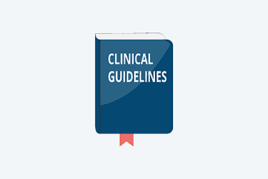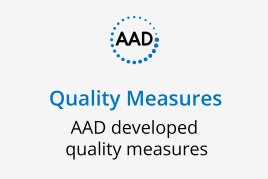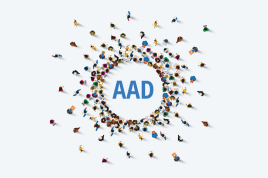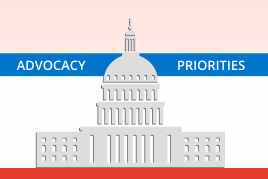Advocacy Update Dec. 17, 2024

IN THIS ISSUE / Dec. 17, 2024
Congress working to partially alleviate 2025 Medicare physician payment cut
AADA works with Midwest Business Group on Health to educate employers
Take action: Comment on USP draft buffered lidocaine monograph
Medicare Physician Payment
Congress working to partially alleviate 2025 Medicare physician payment cut
Currently, Congress is working on a tentative legislative deal to continue funding the government, including an agreement to partially mitigate the 2.8% cut in physician Medicare pay scheduled to take effect Jan. 1. Following AADA advocacy in leading the charge to reform the Medicare payment system, Congress hopes to offset 2.5% in conversion factor cuts for 2025. This deal is still tentative until Congress votes on legislation, which must occur before government funding expires on Dec. 20.
If you haven't already, please urge your Member of Congress to pass legislation before the end of the year to stop the 2025 cuts to Medicare physician payment.
It remains to be seen if the incoming Trump Administration and Congress will prioritize Medicare physician payment reform, but the AADA will continue to be laser-focused on our sole congressional priority.
Payer Advocacy
AADA works with Midwest Business Group on Health to educate employers
The AADA is working to increase awareness among employers of the impact skin conditions have on employee health, productivity, and costs. Most recently, we presented a webinar for employers with the Midwest Business Group on Health (MBGH), a non-profit association comprised of more than 150 companies.
The “Skin Cancer, Psoriasis, & Atopic Dermatitis: When a Spot or Rash is More than a Spot or Rash” webinar was hosted by David Harvey MD, FAAD, Patient Access and Payer Relations Committee member. He presented a clinical update on dermatologic diseases and promoted early diagnosis and appropriate treatment by a board-certified dermatologist. Dr. Harvey also provided guidance on benefit plan design in support of dermatologist-led prevention and treatment.
In addition to the webinar, the MBGH will roll out two new action briefs developed by an AADA/MBGH employer workgroup with recommendations for employers on benefits coverage for skin cancer (available now) and psoriasis and atopic dermatitis (available in January).
Regulatory Advocacy
Dermatology societies address patch testing policy issues
The American Contact Dermatitis Society (ACDS) and AADA are collaborating to address several emerging regulatory issues related to patch testing by forming working groups to work with the Food and Drug Administration (FDA) and other stakeholders.
The AADA and ACDS aim to ensure access to these essential diagnostic tools by engaging with the FDA and stakeholders. The ACDS met with the FDA earlier this year, and AADA met with agency officials on Dec. 13.
For more information, contact AADA’s Regulatory Policy team at regulatory@aad.org.
iPLEDGE
AADA presses for iPLEDGE REMS program changes
The AADA requested an update from the FDA (PDF) on changes to the iPLEDGE Program announced at the end of 2023 and asked the FDA to require that dermatologists be invited to participate in the development, testing, and evaluation of changes to the iPLEDGE REMS program.
The AADA contacted the Isotretinoin Products Manufacturer Group (IPMG), which confirmed it is still awaiting FDA feedback on several of its proposals to implement the mandated changes. Thus, the changes were not ready within the year’s timeframe.
To assist AADA in urging the FDA and IPMG to move faster on the updates, members are encouraged to share their stories with the AADA on the impact the delay in implementing these changes has on them and their patients.
Lidocaine Regulation
Take action: Comment on USP draft buffered lidocaine monograph
As a reminder, AADA has resources for members to submit comments to the United States Pharmacopeia (USP) by Jan. 31, 2025. It is critical that dermatologists submit their comments to USP to help ensure better time frames to prepare and administer buffered lidocaine.
On Nov. 1, USP published a draft Lidocaine Hydrochloride and Epinephrine Buffered Compounded Injection monograph which incorporated testing conducted by the American Academy of Dermatology Association, American College of Mohs Surgery, American Society for Dermatologic Surgery Association, and American Society for Mohs Surgery.
AADA News
Editor’s note: Next issue of Advocacy Update will be Jan. 7
Advocacy Update will take a scheduled break until Jan. 7. Check out the AADA’s social media channels for any advocacy breaking news and watch for an email alert if Congress acts on Medicare payment.
AADA News
Contribute to SkinPAC
As of Dec. 12, 2024, SkinPAC has raised $1,078,957 from 1,035 contributors.
SkinPAC helps strengthen our relationships on Capitol Hill and reinforces our grassroots and lobbying efforts. Your contribution today will help ensure we have the resources we need to ramp up our fight to reform Medicare physician payment in the new Congress.
Contribute online at www.skinpac.org or by texting SkinPAC to 71777. Email skinpac@aad.org with any questions.
The political purpose of the American Academy of Dermatology Association Political Action Committee ("SkinPAC") is to solicit and receive contributions to be used to make political campaign expenditures to those candidates for elective office, and other federal political committees, who demonstrate understanding and interest in the view and goals of the American Academy of Dermatology Association.
Contributions to SkinPAC are not deductible for federal income tax purposes. Contributions to SkinPAC must be made from your funds and may not be reimbursed. SkinPAC cannot accept contributions from corporate accounts. Any recommended contribution amount is merely a suggestion. All AADA members have the right to contribute more or less or refuse to contribute without reprisal. Federal law prohibits us from accepting contributions from foreign nationals. Federal law requires us to use our best efforts to collect and report the name, physical address, occupation, and name of the employer whose contributions exceed $200 in a calendar year.
 Find a Dermatologist
Find a Dermatologist
 Member directory
Member directory
 AAD Learning Center
AAD Learning Center
 2025 AAD Innovation Academy
2025 AAD Innovation Academy
 Need coding help?
Need coding help?
 Reduce burdens
Reduce burdens
 Clinical guidelines
Clinical guidelines
 Why use AAD measures?
Why use AAD measures?
 Latest news
Latest news
 New insights
New insights
 Physician wellness
Physician wellness
 Joining or selling a practice?
Joining or selling a practice?
 Promote the specialty
Promote the specialty
 Advocacy priorities
Advocacy priorities
